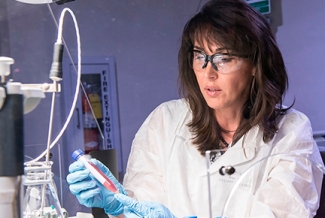"Medieval alchemists tried to create gold from other metals," she said. "That's kind of what we did with our research. It's not real alchemy, in the medieval sense, but it is a sort of 21st century version."
Gold has long been a valuable resource for industry, medicine, dentistry, computers, electronics and aerospace, among others, due to unique physical and chemical properties that make it inert and resistant to oxidation. But because of its high cost and limited supply, large scale projects using gold can be prohibitive. At the nanoscale, however, using a very small amount of gold is far more affordable.
Terrific work by Murph identifying a material substitute that should speed further progress on this limitless frontier. The nanoscale has long held the fascination of physicists and chemists, among others. New breakthroughs depend heavily on the continual refinement of processes and products. We welcome this one, and congratulate Dr. Murph.
Image: Simona Murph in the laboratory.

